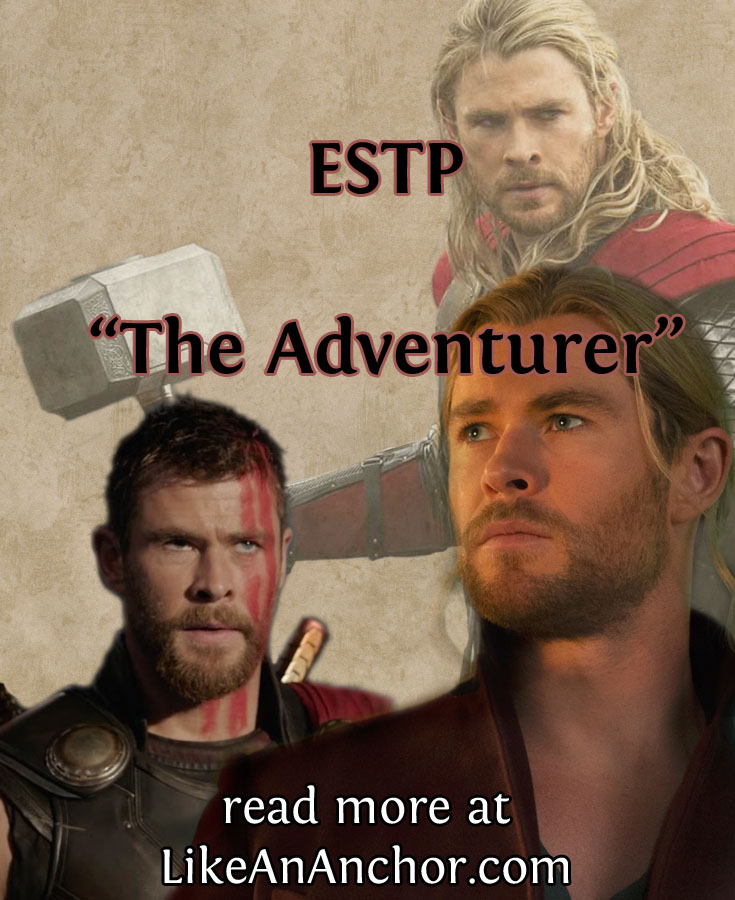With Thor: Ragnarok now out, it seemed like a good time for another Fictional MBTI post, especially since Ragnarok is so good. Who would have thought a film about the destruction of Asgard and fall of the gods (that’s not a spoiler — it’s Norse mythology) could be so light-hearted and fun?
I’ve been typing Thor as an ESTP since the first film came out, which I think is pretty much the standard typing for him (please note: I’m only typing the MCU version of Thor, not his character in the comics or mythology). Still, just because there’s not much debate about his type doesn’t mean we can’t give him his own post. There are several different nicknames for this type, and for Thor I decided to go with “Adventurer” rather than the more commonly used David Keirsey nickname “Promoter.”
A Man of Action
ESTP types lead with a mental process called Extroverted Sensing (Se). Fittingly, this is the most visible aspect of Thor’s character in the films. SP types are doers. They thrive on taking action in the real world and they’re good at it. Really good. In fact, I’d venture a guess that most action heroes in fiction are SP types, especially STP types. It’s not that they can’t pause for reflection or plan ahead. It’s that they don’t really see the need since things usually work out so well for them.
ESTPs have a reputation for being thrill-seekers, and it’s not hard to see why. Their dominant Se seeks variety and physical stimulation. They like to take risks, yet they are so aware of their physical surroundings and their limits that they are probably the smartest physical risk-takers around. They have a natural awareness for what their body can or can’t do, paired with quick reflexes, and an ability to keep their wits in a crisis.” — Susan Storm, Understanding ESTP Sensing
This side of Thor’s character is at the forefront in the new film as well as his past appearances. In Ragnarok’s opening scene, he even comments that fighting against overwhelming odds without a real plan seems to always work out for him. And not only does it work out, he’s clearly enjoying himself. He thrives on challenge and risk-taking.
Thoughtlessly Charming
I’m going to skip over an ESTP’s co-pilot process for now and talk about their tertiary side. It’s tempting for any type to bypass their secondary function and spend more time in their less-developed tertiary side because that lets them stay in their preference for introversion or extroversion. For example, an ESTP’s primary and tertiary functions are both extroverted, while their secondary one is introverted.
Extroverted Feeling (Fe) isn’t all that well-developed or reliable for ESTPs. It can lead to bad decisions based on doing things that will make them look good to or fit in with the people around them (Fe is a process focused on harmony in relationships). Thor is clearly enjoying his social position in the opening scenes of the first film and I suspect that a large part of how he acts is because “reckless military leader” is the persona people expect (though I doubt he’s analyzed it that much). We also see him using his Fe to connect with people on earth as the charming gentleman Jane Foster falls in love with.
Learning After Doing
ESTPs learn best by doing. They’re not the sort to listen to lectures or spend a lot of time planing. They’d rather do something and see how it works out, then adjust future actions accordingly. Until something doesn’t work out there’s not much of a reason for them to spend time figuring out why. Which leads us to a discussion of an ESTP’s secondary function, Introverted Thinking (Ti).
Most people start to develop their secondary function in their teens, but it’s not a comfortable process for people to be in so we don’t always focus on growing it until we have to. For ESTPs, this “co-pilot” is a judging function that they use when making decisions. Ti is concerned with figuring out what makes sense, aligning to personal convictions, and impartially looking at facts. Thor starts doing this when his exile from Asgard in his first film forces him to look at the sort of decisions he’s been making and re-think his actions.
We do also get glimpses of an ESTP’s healthy thinking side in Thor’s character. People of this type can be incredibly clever and intelligent, though they’re often underestimated because so many outsiders just see their action-oriented side. An example from the first film is when he’s explaining the science behind Bifrost travel to Jane. He makes it look easy, but he’s managing to translate two completely different cultural way to framing the world (science and magic) in a way that makes perfect sense to an earth scientist. And in Ragnarok, we get a conversation between him and Bruce Banner where Thor effortlessly keeps up with and understands the scientific terminology used by a man with multiple PhDs.
Stress And The ESTP
Being cast out of Asgard in the first film, and especially learning that Mjölnir doesn’t see him as worthy anymore, pushes Thor into his least developed function. For ESTPs, that’s Introverted Intuition (Ni). When intuition is a type’s stress function, stressful situations tends to confuse their normally clear thought process and they may become angry, paranoid, or feel hopeless. It typically doesn’t take ESTPs long to bounce back, though, which helps explain why Thor’s despondency only lasts until he’s given a chance to take action and fight back.
What’s really interesting about Thor of the MCU films is that this version of his brother Loki is an INFJ type. Making Loki and Thor complete opposites in their personalities means they use the exact same mental functions in the opposite order. Thor’s weakest mental process is Loki’s strongest (INFJs lead with Ni), and vice-versa. No wonder they’re constantly butting heads and struggling to understand each other.
If you enjoyed this post, check out my other MCU typings:
Bucky Barns – ESTP
Loki – INFJ
Scott Lang -ISFP
Steve Rodgers – ISFJ
T’Challa – ISFP
Tony Stark – ENTP
Save
Save
Save
Save
Save
Save
Save
 While the film has been well received overall, some are describing the deaths that do happen (and in some cases the whole movie) as pointless because we “know” pretty much how this is going to go. Coulson and Loki have already come back from death scenes in the MCU. It’s something we expect from the genre. And some of the characters that died at the end have sequel movies that are filming right now. We assume they won’t stay dead, and so might conclude that their deaths don’t matter.
While the film has been well received overall, some are describing the deaths that do happen (and in some cases the whole movie) as pointless because we “know” pretty much how this is going to go. Coulson and Loki have already come back from death scenes in the MCU. It’s something we expect from the genre. And some of the characters that died at the end have sequel movies that are filming right now. We assume they won’t stay dead, and so might conclude that their deaths don’t matter.





